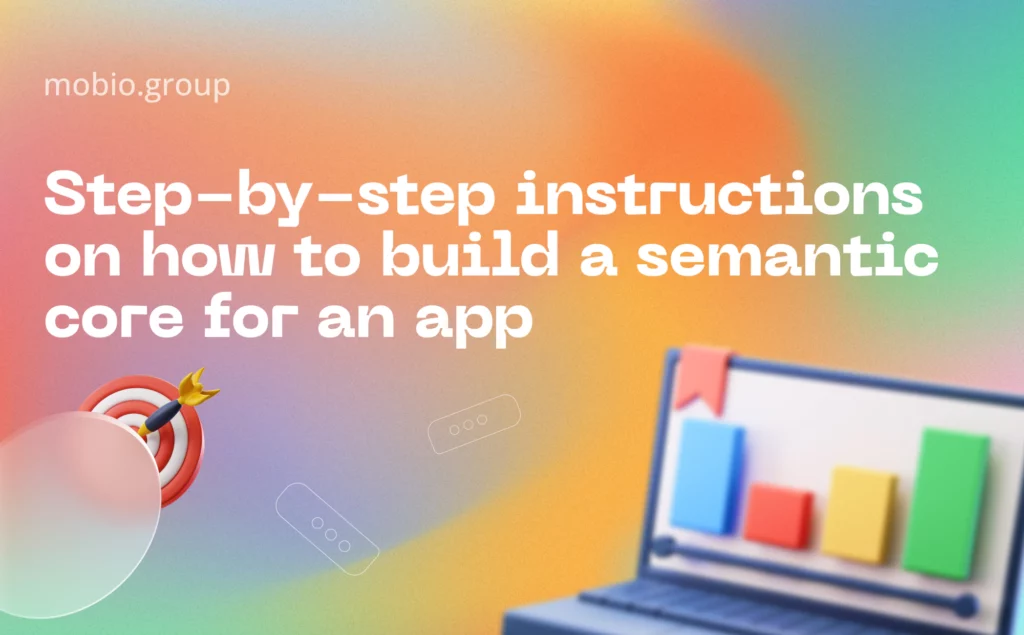Step-by-Step: App Semantic Core Development | Mobio Group

Let’s start with the definition of “what is the semantic core” — this is a list of keywords of a certain frequency for which people find our advertisement, site or application.
In this article, Mobio Group will answer the questions:
1. How to build a semantic core for your applications?
2. What a semantic core is for?
3. Tips for building a semantic core.
What is the Semantic Core for?
1. Visually see what keywords our target audience is interested in or can find our product for.
2. See how many people approximately enter the queries we need, broken down by geo, months and devices.
3. Select a pool of keywords for advertising placement that will bring us the most profitable traffic.
What are the Semantic Cores for Apps
Semantic core — as we found out earlier, the list of keywords, before collecting it, you need to decide on the target audience and the product that you will advertise.
Before compiling the Semantic Core, it must be divided into clusters (in the usual Google docs, Excel)
Main divisions by clusters: brand queries, targeted and near-targeted.
Additional division by clusters: transactional, competitive, with geo.
Brand queries — those that include your product and brand name or just the brand name (first, you need to check if there are no competitors or other campaigns with a similar name in placements). Generally considered one of the cheapest traffic channels and effective in terms of KPI , a person is familiar with your brand, website or application and is ready to interact with you again.
But! If your business or application is unknown, there are no queries mentioning your brand, you will have to use other clusters.
Target queries are those that suit you, without mentioning the brand. Example — a bicycle, a two-wheeled bicycle.
Mobio Group Tip: Depending on the topic, the auction here can be overheated, the cost of placement can be expensive and not the most effective, + to buy a large amount of traffic, you need a large budget.
Near-target — those that are indirectly related to you, for example, a speed bike, an adult bike, a folding bike.
Mobio Group Tip: This classification should be tested carefully, it often happens that the cost of a client is very expensive or you need to change the placement strategy, but again, depending on your goals. If it’s a simple visit to the site or download the application, it will do to find out about any event.
Keywords are collected separately: brand, target and near-target, as well as additional divisions.
Additional Breakdown by Clusters
Transactional – depending on your strategies, these are keywords, with a mention: price, buy, order, book, register, download, install the application and so on.
These words, as a rule, lead to a quick solution to the problem, since a person enters a ready-made request for a purchase or action, they are considered hot requests and usually cost more than others at the auction.
Competitive requests – mentioning a product, application, or service with a competitor’s brand name. A simple mention of a competitor’s store
An example with a product — Stealth bicycle, Merida bicycle.
Application example — Decathlon application, Sportmaster application, sporting goods application.
You also need to carefully test this topic, it often happens that one store is expensive, the other, on the contrary, is good. Keep your finger on the pulse of the test!
Keywords with geo — those keywords where the key includes the mention of the city. Bicycle London, Bicycle New York, Bicycle Toronto.
This is convenient for dividing the campaign by geo in the future (since the cost of the auction will differ depending on the geo) this approach will be useful in terms of control over certain cities, reduces the cost of traffic, + is quite effective, since a person searches by geo for what is nearby, and you just need to provide this opportunity.
We have analyzed what the semantic core is and what types of cores exist. Before collecting keywords, let’s look at the other side of the coin, negative keywords.
Negative words — These are the words that we obviously do not need, when placing which, the user will not look for what we are broadcasting to him or a completely different campaign.
For example: China, eBay, children, etc. (from the subject, the words will be different).
Let’s Move on to Composition
Prepare yourself a file where you will insert keywords. You can divide by clusters, as you like, with different columns and naming or tabs.
In one column we will have keywords, and in the other negative keywords.
The file is ready, we are starting to collect the semantic core. First of all, we enter our brand and add words to the column.
Attention! Negative words, put in a separate column + delete or do not take the request to the location where this word exists, only negative words.
Thus, we will get columns with keywords and negative words. We fill in all clusters with negative words, in the future for each direction, they will be different.
Now you have a semantic core and negative words that are divided into categories: brand, general, target, etc. It is worth noting that the campaigns that you will create should be all different, for each category of keywords. This way you will understand which semantic core works effectively, which does not or needs to be improved.
P.S. We at Mobio Group are always responsible for high-quality traffic and are ready to share our experience and insights with you.
Lifehacks
1. Let’s start with negative words
Those words that we collected at the beginning, does not mean that the work on them is over. In the process of advertising, in the statistics of search queries, you can find new non-target words for which people are looking for you or go to your ad. From these statistics, we take extra words, add them to the minus words file + duplicate them in the list of minus words in the campaign itself.
IMPORTANT! This must be done for each campaign separately.
2. For convenient collection of the semantic core, use the browser extension
It will allow you to quickly add the necessary words to the list, and already from the window, copy with or without frequency to Excel, so much easier and faster than transferring one word at a time.
3. If you have a large semantic core, many divisions and keywords, then it is best and fastest to use a parser that collects the keywords for you.
The most popular — Key Collector (paid). The principle of working with the parser is not complicated, you can have a good proxy, you can collect words throughout the country or a specific geo, you can immediately divide into clusters into folders and parse into each individual semantics and not all in a crowd.
4. Tip — write text ads and place banners directly under your semantic core cluster
For example: if it is a brand, then the ads should also be with the brand in the header or banners, so the ad will be more relevant and stand out from the rest, as you can see in the picture below.
In Mobio Group we are always happy to share our experience and tips on setting up traffic and new features. Contact us newbiz@mobiogroup.com, we will be happy to share our experience with you.


